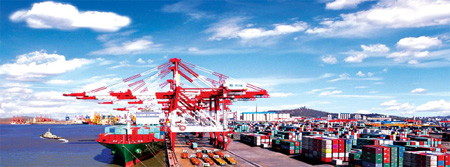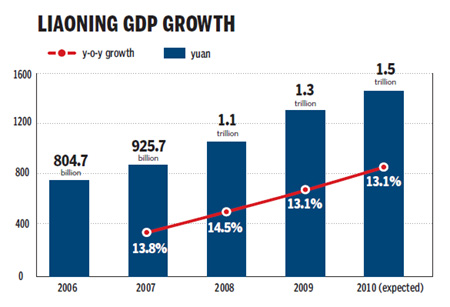InfoGraphic
Coastal opening affects the interior of the province
By Wu Yong, Liu Ce and Cui Xiaoqing (China Daily)
Updated: 2010-12-02 17:29
 |
Large Medium Small |
|
 |
| A number of years ago this was just an ordinary fishing village, but now the port of Yingkou is part of a large coastal economic belt. It handled 200 million tons of freight by the end of November. |
|
 |
| The Arafura Lily docking at the port of Yingkou.[Photo/China Daily] |
When the Fengli left the ore terminal at the port of Yingkou on Nov 19, loaded with ore, it was a milestone for the port- it had handled 200 million tons of freight in 2010, putting it in second place in Liaoning, and ninth in China.
That same day, container traffic at the port, for 2010, hit a new high - 3-million twenty-foot-equivalent units (TEU) - setting a new port record.
"Liaoning province's marine development strategy has contributed a lot to Yingkou port's development," said Gao Baoyu, head of the port.
Liaoning's coastal development has also boosted the whole province's economy.
Revamp
The State Council approved the Liaoning Coastal Economic Belt Development Plan as part of a national strategy, on July 1, 2009.
"The nation's support was the biggest motivator in local economic development. It's a milestone in Liaoning history. The coastal economic belt will stimulate the economy of the whole province and even Northeast Asia," said Feng Guisheng, head of the Liaoning Social Sciences Academy's economic research institute.
The Yingkou development has demonstrated the effect of government support. Five years ago, its Bayuquan development zone was just an ordinary fishing town. Now, it has a myriad of tall buildings and throngs with visitors.
Wang Libang, who is 63, does his morning exercises in Bixiashan Park. Looking around at the broad avenues and high-rise buildings around the park, he told China Daily, excitedly, "Bayuquan feels like Shenzhen where I've worked, it's developed so fast, even faster than Shenzhen."
Wang is right. Bayuquan's economic indicators were up 30 percent from 2006 to 2010. This year, its GDP is expected to reach 40 billion yuan, with revenues of 2 billion yuan, or 5.7 times what they were in 2006.
|
||||
The delegation also predicted that "Yingkou will develop into a major international port and distribution center in Northeast China, the eastern part of the (then) Soviet Union, Mongolia and the inner Mongolia autonomous region. And it will become a scientific metropolis with prosperous economy with a galaxy of talent."
That prediction, it seems, is becoming true, step by step, thanks to the Liaoning Coastal Economic Belt Development Plan.
The development of Yingkou is an example of Liaoning's speed and the new look of Liaoning's economic and scientific development.
The GDP of the Liaoning Coastal Economic Belt increased 372.4 billion yuan since 2005. In 2009, it had doubled to 761.4 billion yuan.
"For Liaoning province, the major significance of the development of the coastal economic belt is that it has stimulated the interaction between the coastal area and the interior, activating the economy of the whole province," said Tang Shenfei, secretary-general of Liaoning's opening-up office.





